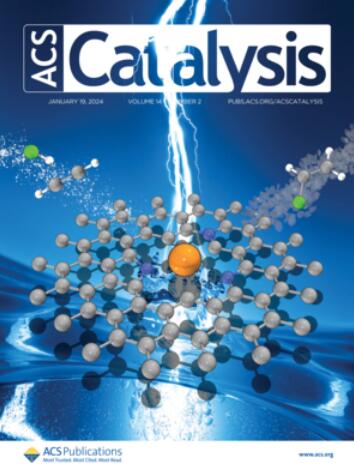Visible Light Promotes PIII/PV‑Catalyzed Reductive N‑Arylation of Nitroarenes at Room Temperature
IF 13.1
1区 化学
Q1 CHEMISTRY, PHYSICAL
引用次数: 0
Abstract
Visible-light irradiation is found to accelerate the reductive coupling of nitroarenes and arylboronic acids under the conditions of PIII/PV catalysis. Specifically, blue-light (λexc = 427 nm) illumination of a catalytic mixture composed of a redox active main group catalyst (1,2,2,3,4,4-hexamethylphosphetane可见光促进室温下PIII/PV催化硝基芳烃的还原N -芳基化
在PIII/PV催化条件下,发现可见光照射可加速硝基芳烃与芳基硼酸的还原偶联反应。具体来说,在蓝光(λexc = 427 nm)照射下,由氧化还原活性主基团催化剂(1,2,2,3,4,4-六甲基磷-氧化物,即P·[O])和末端还原剂(1,3-二苯基二硅氧烷)组成的催化混合物能够在室温下由硝基芳烃和芳基硼酸生成二芳胺。原位31P核磁共振数据证明了氢硅烷还原剂快速原位PVO→PIII还原的重要性,以允许生产室温还原偶联。此外,目前的光化学方法扩大了有机磷催化的还原偶联反应的范围,以适应2,6-二取代的硝基芳烃,这些硝基芳烃在先前的热(暗)反应条件下反应性很差。瞬态吸收实验与硝基芳烃激发产生三重态激发态相一致,该激发态由催化剂PIII静息态的分子间电子转移猝灭,速率常数接近扩散控制极限(k q = 2.93 × 109 M-1 s-1)。这些结果建立了PIII/PV催化循环与光子输入的成功界面,为利用基于有机磷的催化中间体的光驱动方法提供了更多的机会。
本文章由计算机程序翻译,如有差异,请以英文原文为准。
求助全文
约1分钟内获得全文
求助全文
来源期刊

ACS Catalysis
CHEMISTRY, PHYSICAL-
CiteScore
20.80
自引率
6.20%
发文量
1253
审稿时长
1.5 months
期刊介绍:
ACS Catalysis is an esteemed journal that publishes original research in the fields of heterogeneous catalysis, molecular catalysis, and biocatalysis. It offers broad coverage across diverse areas such as life sciences, organometallics and synthesis, photochemistry and electrochemistry, drug discovery and synthesis, materials science, environmental protection, polymer discovery and synthesis, and energy and fuels.
The scope of the journal is to showcase innovative work in various aspects of catalysis. This includes new reactions and novel synthetic approaches utilizing known catalysts, the discovery or modification of new catalysts, elucidation of catalytic mechanisms through cutting-edge investigations, practical enhancements of existing processes, as well as conceptual advances in the field. Contributions to ACS Catalysis can encompass both experimental and theoretical research focused on catalytic molecules, macromolecules, and materials that exhibit catalytic turnover.
 求助内容:
求助内容: 应助结果提醒方式:
应助结果提醒方式:


